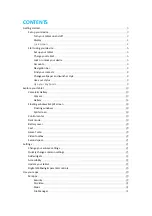
DLI 8300 PRODUCT MANUAL
PAGE 19/50
Rev. 4
Using the WiFi Radio
The DLI-8300 has an optional PCMCIA Summit Data Communications 802.11b/g radio card or
Integrated USB Ralink 802.11b/g/n Radio. Your DLI Sales representative will be able to provide
you with the best option based on your configuration.
Summit Data Communications PCMICA 802.11b/g Radio
The PCMCIA Summit Data Communication card is configured using the Summit Client Utility
(SCU)
.
The SCU provides the following features to Administrators and end-users:
Disable the radio (turn it off) and enable the radio (turn it on)
View the contents of configuration profiles, or profiles, each of which houses the RF,
security, and other settings for the radio
Select the profile to be used to connect to a WLAN
View global settings, which apply to every profile
View status information on the radio, the access point (AP) or WLAN router to which it is
connected, and the RF connection or link between the two
To troubleshoot a connection or performance issue, view in-depth diagnostic information
on the connection and the radio, and perform various troubleshooting and diagnostic
tests
After completing an administrator login to the utility, a user can perform these additional tasks:
1. Create, rename, edit, and delete profiles
2. Alter global settings, which apply to every profile
SCU provides a graphical user interface (GUI) for access to all of its functions. Access to these
functions also is available through an application programming interface (API), which an
application programmer can use to enable another utility to manage the radio.
To initialize SCU:
From the Start menu, select All Programs. Then in the directory called Summit select Summit
Client Utility
Or
Click on the Summit Client Utility (SCU) on the Desktop
SCU has five windows: Main, Profile, Status, Diags (or Troubleshooting), and Global. Tabs, which
are shown on the following pages, enable easy navigation between windows.
Summary of Contents for 8300
Page 1: ...Rev 4 ...
















































